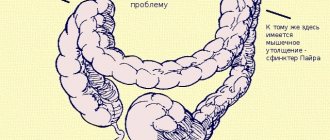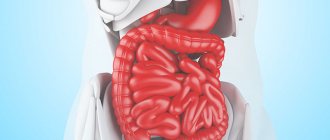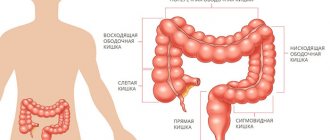Among all nutrition-dependent diseases in children, malabsorption syndrome (MAS) occupies a special place due to its prevalence, polyetiology and severity. SMA is a complex of clinical manifestations caused by disorders of the cavity, parietal, membrane digestion and transport in the small intestine (SI), leading to changes in metabolism. In Russia, the most common forms of SMA in children are disaccharidase deficiency (in particular, lactose intolerance) and celiac disease (gluten intolerance). It is these forms of SMA that will be the main focus of this review.
Etiology and pathogenesis
SMA is caused by many causes, which can be divided into three main groups:
- preenteral (diseases of the stomach, liver and biliary tract, pancreas, cystic fibrosis);
- enteral (for example, disaccharidase deficiency, celiac disease, dermatitis herpetiformis, malabsorption of folic acid and vitamins, giardiasis);
- postenteric (for example, exudative enteropathy, circulatory and lymph circulation disorders in the TC, lymphogranulomatosis, lymphosarcoma).
Cavitary digestion is impaired when the activity of TC enzymes, such as enteropeptidase and duodenase, decreases. Changes in hyperphase in the lumen of the mast cell, the motor-evacuation function of the mast cell, the quantity and quality of food and the activity of a number of regulatory peptides are all factors that can disrupt cavity digestion. There are hormonally active tumors (gastrinoma, VIPoma, somatostatinoma, etc.) that produce regulatory peptides and occur with severe digestive disorders. In cystic fibrosis, the cause of SMA is a decrease in the activity of pancreatic enzymes and a violation of the viscosity of secretions. A number of infectious and parasitic diseases also lead to SMA.
The processes of parietal and membrane hydrolysis of food and absorption also depend on a number of factors, among which we can mention the activity of enzyme and transport systems, the state of the mucous membrane, the composition of the microflora, etc. The functional activity of enterocytes depends on their position on the villus, differentiation, rate of renewal and migration, state of the glycocalyx and the parietal layer of mucus.
Damage to the TC and a decrease in the absorption area are accompanied by the formation of SMA. Therefore, with short bowel syndrome (congenital or post-resection) and villous atrophy, which occurs with celiac disease, microbial infections, giardiasis, exposure to certain medications and radiation, very severe changes occur in many types of metabolism, the physical and sometimes mental development of the child suffers.
Abnormalities of the circulatory and lymphatic systems of the TC also lead to SMA. For example, idiopathic intestinal lymphangiectasia is characterized by severe loss of proteins, lipids, and calcium in the gastrointestinal tract (GIT).
SMA is observed in many hereditary and congenital diseases in which the absorption of amino acids, monosaccharides, trace elements, electrolytes, lipids, and bile acids is impaired (Table 1).
Principles of diagnosis and treatment
Diagnostics
SMA does not have a clearly defined clinical picture. Thus, disaccharidase deficiency, impaired absorption of glucose and galactose, congenital chloridorrhea, and VIPoma are characterized by watery stools. On the contrary, with cystic fibrosis, abetalipoproteinemia, celiac disease, and exudative enteropathy, steatorrhea is observed. If the absorption of microelements, amino acids, and vitamins is impaired, there is no diarrhea, and the symptoms are caused by a deficiency of certain metabolites and may reflect dysfunction of many organ systems.
Due to the heterogeneity of SMA symptoms, the diagnostic algorithm can be very complex and include many biochemical and instrumental examination methods. But first of all, a thorough history collection is necessary, especially information about the child’s nutrition (Table 2).
For differential diagnosis, it is also very important to know at what age the first symptoms of the disease appear. In the neonatal period, they manifest: congenital and secondary lactase deficiency, impaired absorption of glucose and galactose, congenital chloridorrhea, congenital sodium diarrhea, hereditary trypsinogen and enterokinase deficiency, primary hypomagnesemia, primary immunodeficiency, acrodermatitis enteropathica, intolerance to cow's milk and soy, Menkes syndrome. At the age of one month to 2 years, the following symptoms appear: sucrase-isomaltase deficiency, secondary disaccharidase deficiency, congenital lipase deficiency, Shwachman syndrome, celiac disease, intestinal lymphangiectasia, biliary atresia, neonatal hepatitis, malabsorption of amino acids, folic acid and vitamin B12, enteropathic acrodermatitis, parasitic infections, food allergies, immunodeficiency. From the age of 2 years to puberty, the following symptoms appear: secondary disaccharidase deficiency, celiac disease, Whipple's disease, parasitic infections, variable immunodeficiency, abetalipoproteinemia.
Treatment
The patterns of development of the pathological process and the main pathological symptom complexes in different types of SMA are similar, therefore the tactics of managing patients with this pathology depend little on etiological factors. The main methods of treating patients with SMA are diet and therapeutic nutrition, the main principles of which are the identification and elimination of foods that cause SMA, with their adequate replacement, as well as an individual approach to the preparation of an elimination diet.
Drawing up a menu for children with SMA requires a doctor to be highly qualified and knowledgeable from various fields of theoretical and practical medicine. Should be considered:
- hereditary or acquired malabsorption disorders requiring the fastest possible correction;
- the degree of malnutrition and the resulting violation of tolerance to food load;
- condition of the liver, pancreas and kidneys, limiting the amount of proteins and fats in food;
- high sensitivity of the intestines of sick children to osmotic load;
- child's age;
- the child’s appetite, eating habits and preferences.
An important component of successful nursing for children with SMA is proper care and prevention of secondary infectious complications. In order for the doctor’s prescriptions to be followed, it is necessary to involve the mother of the sick child in the care and feeding, since the effectiveness of therapy depends on her skills and motivation, especially in an outpatient setting.
Rare forms of SMA, caused by genetic defects in enzyme and/or transport systems in the body or congenital morphological abnormalities of the gastrointestinal tract, require specific examination and therapeutic, and sometimes surgical treatment in specialized medical centers with the involvement of highly qualified medical specialists.
Disaccharidase deficiency
Etiology. Intolerance to disaccharides (lactose, maltose, sucrose) is caused by a decrease in the activity of hydrolases (lactase, sucrase, isomaltase) in the mucous membrane of the thyroid gland (Fig. 1).
Violation of parietal hydrolysis of disaccharides and absorption of monosaccharides can be primary (hereditary) or secondary (occur against the background of various diseases).
Pathogenesis. With a deficiency of disaccharidases, undigested carbohydrates accumulate in the lumen of the mast cell. An increased osmotic pressure is created, which leads to an excess flow of water into the lumen of the TC. Disaccharides are utilized by microflora, a large amount of organic acids and CO2 are formed, which further increases the flow of water into the lumen of the TC. The pH of the stool decreases (<5.5), and watery, foamy stools with a sour fermentative odor are formed. Disaccharides are excreted in unbroken form both in feces and urine (lactosuria, saccharosuria). The development of SMA is caused by the osmotic effect and disruption of the microflora of the MC. However, disaccharidase deficiency does not manifest itself in all patients, since compensatory mechanisms are activated: increased activity of membrane, lysosomal and mitochondrial enzymes in the colon. The liver plays a well-known role in neutralizing toxic products coming from the TC.
Lactase deficiency
This fermentopathy is of particular importance in early childhood, since lactose is contained in milk, which is the main nutrition of the child. Lactase (beta-D-galactosidase) is synthesized primarily in differentiated enterocytes at the tip of the villi. This topography explains the most common occurrence of lactase deficiency when the mucous membrane of the mast cell is damaged compared to deficiency of other enzymes.
Lactase activity is maximum in newborns, and decreases slightly in the postnatal period (up to the age of 6–12 months). Then there is a further decrease in activity, and by 3–5 years, lactase activity becomes the same as in adults. The prevalence of lactase deficiency in the population varies between countries and regions. For example, in Russia as a whole it is 16%, in Karelia – 11.5, in the Republic of Mari El – 81.
The severity of clinical manifestations of lactose intolerance does not always correlate with the degree of decrease in lactase activity. Lactose intolerance is related to both the activity of enterocytes and the number of lactose-fermenting bacteria. A large number of factors are known that influence the activity of enterocytes. For example, epidermal growth factor stimulates the expression of brush border enzymes. It has been proven that large amounts of epidermal growth factor are present in breast milk. Insulin, thyroid hormones, glucocorticoids, and the state of the autonomic nervous system are also of great importance for lactase activity. The manifestation of lactase deficiency symptoms also depends on the composition of the diet. Thus, consuming lactose along with fats reduces lactose intolerance.
The clinical picture can appear already in the first days of life (fast stools, watery, foamy, with a sour odor, appears 30–90 minutes after feeding; vomiting, regurgitation). Abdominal colic is characteristic, which can appear even during feeding. Osmotic diarrhea and water and electrolyte imbalance occur. The epithelium of the mast cell is unstable to water-electrolyte fluctuations, therefore its permeability to macromolecules increases and lactose is excreted in the urine.
Lactase deficiency is combined with MC dysbiosis, which affects the symptoms and duration of clinical manifestations. A significant amount of undigested lactose in the lumen of the MC with an increased number of bacteria leads to the formation of a large amount of organic acids, which causes pronounced acidification of the internal environment and increased motility of the MC. In premature infants, foods containing lactose can cause metabolic acidosis.
The diagnosis is established on the basis of genealogical data, a flat glycemic curve after a lactose load, scatological examination data (increased starch, fiber content; stool pH < 5.5), determination of carbohydrates in stool using Testape strips, Benedict's test (normally the indicator does not exceed 0 .25% in children under 12 months and negative after a year). The gold standard for diagnosing lactase deficiency is assessing the activity of disaccharidases in biopsy samples of the mucous membrane of the colon or in washings obtained during gastroscopy.
Treatment. The main way to treat lactase deficiency is diet therapy, which consists of reducing the consumption of foods containing lactose. Enzyme preparations that break down lactose are also used; dietary fiber (especially pectin), which increases lactase activity; drugs that normalize calcium metabolism; drugs that restore the microflora of the TC.
Reducing milk intake is easy in older children and adults. It is allowed to use fermented milk products with a reduced amount of lactose (yogurt, curdled milk), cottage cheese, butter, hard cheeses, as well as lactose-free products based on cow's milk (Table 3). The decrease in calcium levels on a dairy-free diet should be taken into account, which must be compensated for with medications.
It is more difficult to choose nutrition for young children, especially in the first year of life. When breastfeeding, a decrease in the amount of breast milk is undesirable, so a child with severe lactase deficiency must be prescribed lactase preparations - Lactase, Lactaid, Lactrase, which are mixed with breast milk. These drugs increase the total lactase activity of breast milk without affecting its other properties. For adults, lactase capsules can be used.
We studied the effectiveness of a lactase preparation from Nature's Way (USA) in the form of Lactase capsules (with an activity of 3450 IU of lactase) in young children with lactase deficiency [2]. Lactase doses ranged from 575 units (1/6 capsule) to 865 units (¼ capsule) per 100 ml of breast milk. Lactase has been shown to effectively compensate for lactose intolerance. It is recommended to add the drug to the first portion of pre-expressed milk and leave it for a few minutes to begin fermentation. Milk with the drug is given from a spoon or sippy cup; then the child is breastfed. The drug should be given at every feeding. In case of severe lactase deficiency or low effectiveness of lactase preparations, the question may arise of partially reducing the volume of mother's milk and replacing it with a lactase-free formula (Fig. 2).
It is important to remember that the amount of lactose in breast milk does not depend on the mother’s nutrition and an overly strict diet can negatively affect the quantity and quality of milk, as well as the emotional state of the mother. It is necessary to limit the child's consumption of products with a high content of whole cow's milk to prevent allergies to cow's milk protein and the formation of secondary lactase deficiency.
When artificially feeding premature newborns who have transient lactase deficiency, it is advisable to use specialized milk formulas, where the lactose content is slightly reduced and amounts to 3.6–6 g/100 ml. Such mixtures include Pre-NAN (Nestle, Switzerland), Pre-Nutrilak (Nutritek, Russia), Pre-Nutrilon (Nutricia, the Netherlands), Humana 0 and Humana 0-HA (Humana, Germany), Frisopre (Friesland Nutrition, the Netherlands ), Enfalak (Mead Johnson, USA) [3].
If signs of lactase deficiency appear in full-term newborns, it is not advisable to immediately transfer such children to a strictly lactose-free diet, since the presence of lactose in the diet is important for normal development. Lactose serves as the main and easily digestible source of energy; it helps maintain the transport of calcium, magnesium and manganese in the TC. The complete exclusion of lactose has an adverse effect on the biocenosis of the gastrointestinal tract, since lactose is a substrate for lactic acid bacteria. Lactose is also a bifidogenic factor. Undigested lactose is fermented in the colon, lowering the pH in its cavity and thereby preventing the growth of putrefactive microflora. In addition, lactose is a source of galactose, which is necessary for the synthesis of galactocerebrosides in the central nervous system and retina.
If, during artificial feeding, the carbohydrate content in feces is 0.3–0.6%, you can switch to a diet containing up to 2/3 of carbohydrates in the form of lactose, combining regular milk formulas with low-lactose or lactose-free ones (Table 4). In this case, it is necessary to distribute the mixture evenly (for example, give 40 ml of low-lactose and 80 ml of regular mixture at each feeding).
Another possible option for diet therapy in full-term newborns with lactase deficiency is the administration of Lactofidus fermented milk mixture (Danone, France) as monotherapy. In this mixture, lactose makes up about 60% of all carbohydrates, but the mixture contains bifidobacteria and has a fixed lactase activity (28 IU/100 ml).
In young children, lactase deficiency is often combined with cow's milk intolerance. In this case, for children under 6 months of age, formulas based on partial or complete protein hydrolyzate are preferred (and for children over 6 months of age, based on soy protein; Table 5). If the allergic process is severe and dystrophy is present, mixtures based on partial or complete protein hydrolyzate are used, regardless of the child’s age.
Violation of the function of mast cells and its permeability makes it necessary to change the timing of the introduction of complementary foods in children of the first year of life suffering from lactase deficiency. Fruit and berry juices, fruit purees, cottage cheese, and egg yolks are introduced into the diet later, and vegetable and meat purees - earlier than in healthy children. In this case, preference is given to low- or lactose-free products, and dairy-free instant cereals are recommended as the first complementary food. They are brewed with water or a mixture that the child receives.
In addition to diet therapy, drug treatments can also be used if necessary. For severe diarrhea, loperamide can be used, given in a short course in combination with an elimination diet. In severe cases of the disease, accompanied by electrolyte and metabolic disturbances, their correction is necessary. For this purpose, isotonic solutions of glucose, sodium chloride, and potassium chloride are used.
An important link in the treatment of children with lactase deficiency may be the normalization of the gastrointestinal microflora. In the presence of putrefactive and fermentative flora, it is advisable to use lactulose preparations with caution - Lactusan and Prelax (Felicata Holding, Russia), Duphalac (Solvay Pharmaceuticals, Germany - France), etc. In case of deficiency of lacto- and bifidobacteria, the appropriate groups of pre- or probiotics are selected.
Celiac disease
This is a chronic, genetically determined disease characterized by damage to the mucous membrane of the TB - reversible atrophic enteropathy. Celiac disease occurs under the influence of gluten, a protein from cereal plants. The prevalence of celiac disease among the population of different countries ranges from 0.02 to 0.33%.
Etiology and pathogenesis
Cereal grains contain several protein fractions: albumins, globulins, prolamins, glutenins. Actually, only the last two fractions are called gluten. Gluten is a water-insoluble complex of proteins with a slight admixture of lipids, carbohydrates and salts. It is gluten that gives wheat bread its special properties - softness and fluffiness. Toxic for patients with celiac disease are prolamins (alcohol-soluble proteins rich in glutamine and proline), namely wheat gliadin, rye secalin and barley hordenin - related genera of cereals. The toxicity of oat ovein is unclear, since oats belong to a different taxonomic group. Taking into account the fact that it is impossible to exclude contamination of oat products with other grains, it is also not recommended to use it for celiac disease.
The pathogenesis of celiac disease involves a complex relationship between genetic and environmental factors. Genetic predisposition to celiac disease is determined by alleles of the HLA genes DQA1 and DQB1. Allelic variants DQA1*0501 and DQB1*0201 are expressed in more than 90% of patients with celiac disease.
Gliadin, entering the gastrointestinal tract, penetrates Peyer's patches and activates the T- and B-cell components of the immune system. Migration of lymphocytes into the lamina propria causes its damage. In genetically predisposed patients, T lymphocytes are activated predominantly not by native cereal proteins, but by deamidated gliadin epitopes, which are formed directly in the mucous membrane of the MC with the participation of tissue transglutaminase. Deamidated gliadin binds tightly to transglutaminase, which leads to the production of antibodies to this enzyme. Antibodies to transglutaminase inhibit transforming growth factor-b, as a result of which the differentiation of MC epithelial cells is suppressed and atrophic processes develop in the mucous membrane, resulting in SMA in patients with celiac disease. When eating food containing cereal proteins, the mucous membrane of the TC is damaged quickly: the latent period between the first intake of gliadin and the appearance of clinical symptoms of celiac disease is only 1.5 months.
Clinical picture
In children, celiac disease occurs with the formation of SMA, so the symptoms are characterized by great polymorphism. Based on clinical manifestations, typical and atypical forms of the disease are distinguished. The typical form is more often observed in young children. The first symptoms appear 3–8 weeks after eating foods containing gluten: semolina, oatmeal, baked goods, pasta, and some infant formulas. An early sign of celiac disease may be a change in the nature of stool: it becomes more frequent, the amount of feces increases, which acquires an unpleasant pungent odor and greasy sheen due to steatorrhea, and contains undigested food fragments. At the beginning of the disease, diarrhea is not constant.
Many clinical manifestations of celiac disease are due to the development of SMA. The rate of weight gain and then growth of the child gradually slows down. In children with celiac disease, the psycho-emotional status is impaired (negativism, tearfulness, aggressiveness, lethargy, adynamia), psychomotor development is delayed, previously acquired skills are lost, patients have a characteristic appearance:
- they are emaciated and short;
- the abdomen is greatly enlarged, the limbs are thin, rickets-like;
- There is dystrophy of the skin, nails, hair, teeth, and muscle hypotension.
Carpopedal spasm and hypocalcemic convulsions are often observed, and sometimes swelling and tissue pastiness are observed.
The atypical form occurs in a third of patients and manifests itself at a later age - from 2 to 14 years. In this group, only individual symptoms of celiac disease are more often noticeable, caused by metabolic changes, which in the initial stages of the disease can lead to an incorrect diagnosis. On the one hand, in older children, chronic diarrhea is often absent even if the diet is not followed, since the surface area of the TC where digestive and transport processes take place is larger than in young children. On the other hand, due to late diagnosis and lack of an adequate diet, decompensated metabolic disorders are observed.
Diagnosis is based on the determination of a number of antibodies characteristic of celiac disease, including autoantibodies to endomysium, reticulin and tissue transglutaminase and antibodies to gliadin. In celiac disease, the titers of all or some of these antibodies are significantly increased. The least specific determination of antibodies to gliadin, since they are also expressed in other diseases: Crohn's disease (in 31% of patients), ulcerative colitis (in 13%), diabetes mellitus type 1 (in 14%). Moreover, the frequency of antibodies to gliadin in the population reaches 27%. If there are obvious clinical signs of celiac disease, but low antibody titers, a load test with gliadin can be used, followed by an assessment of the increase in titers. Genotyping of HLA alleles is also recommended.
A morphological study of the mucous membrane of the colon has high diagnostic significance. Characteristic signs of celiac disease: deepening of the crypts, a significant decrease in the height of the villi (up to atrophy), a change in the ratio of villi length/crypt depth, a pronounced immunological reaction in the lamina propria of the mucous membrane (increased number of lymphohistiocytic and plasma cells), changes in enterocytes (dystrophy and swelling), especially on the luminal surface. In celiac disease, the mitotic activity of the crypt epithelium is significantly increased, DNA synthesis is enhanced, and the rate of enterocyte migration is increased. As a result of these processes, mature enterocytes are replaced by less differentiated ones.
Treatment
The main treatment method is a strict, lifelong gluten-free diet. All products containing wheat, rye, barley and oats are excluded. These include baked goods, pastries, pasta, cookies, muffins, many sweets, chocolate, and ice cream. It is also important to remember about products that contain “hidden” gluten (it is not listed in the product, but is contained in it as a technological additive). These products include:
- sausages, frankfurters, semi-finished products from minced meat and fish;
- canned meat and fish, especially in tomato sauce;
- many canned vegetables and fruits, such as tomato paste, ketchup;
- many types of baby canned complementary foods;
- ice cream, yogurt, processed cheese, margarine with gluten-containing stabilizers;
- some types of vinegars and salad sauces, mayonnaises;
- some types of soy sauces;
- concentrated dry soups, bouillon cubes;
- instant coffee, cocoa mixtures, teas for instant preparation;
- multi-component dry seasonings and spices;
- corn flakes with barley molasses;
- imitation seafood, such as “crab” sticks;
- caramel, soy and chocolate candies with filling, oriental sweets, industrial jam;
- kvass, beer;
- some types of toothpaste;
- some medicines (in excipients);
- food additives and dyes E160beta, E150a–E150d, E411, E636, E637, E953, E965, E471.
Gluten-free products are those containing no more than 200 mg of gluten per kilogram of dry matter. A gluten-free diet involves the use of rice, buckwheat, corn, potato flour, soy, various vegetables (potatoes, carrots, cabbage, zucchini, pumpkin, etc.), fruits (apples, pears, bananas, etc.), may include fruit juices, various varieties of meat and poultry, low-fat fish, margarine, vegetable oils, honey, preserves, jams, gelatin. Special gluten-free diets have been developed that are physiological in composition and have a high protein and calcium content.
In children of the first year of life, you can use gluten-free cereals, monocomponent canned baby food and lactose-free formulas, and in severe cases, hydrolyzed mixtures, which significantly reduce the time of parenteral nutrition, if necessary. Here are some examples of such products:
Gluten-free milk porridges:
- Winnie (Kolinska, Poland);
- Milupa (Milupa, Germany);
- Similac (Abbott Laboratories, USA);
- Humana (Humana, Germany);
- Malyshka (McLove, Lavr-K, Russia);
- Top-Top (Nutricia, Netherlands);
- Tutteli (Valio Tutteli, Finland);
- Heinz (Germany).
Gluten-free dairy-free porridges:
- Beech Nut Naturals, USA;
- Vinnie;
- Gerber (USA);
- Nestle (Nestle, Switzerland);
- Similac;
- Heinz;
- Humana;
- Top-Top.
Canned monocomponent meat:
- with beef: Beef puree (Tikhoretsky MK, Russia), Gerber 71 (Gerber, USA), Maklav Malysh (McLove, Lavr-K, Russia), Beef (Tikhoretsky MK, Russia);
- with pork: Ham puree (Tikhoretsky MK, Russia), Gerber 71, Pork puree, Vitaminized pork puree, Khryusha (McLove, Lavr-K, Russia);
- with turkey, chicken, veal: Turkey puree, veal puree, chicken puree (Tikhoretsky MK, Russia), Gerber 71;
- with lamb meat: Lamb puree (McLove, Lavr-K, Russia), Gerber 71;
- with horse meat: Little Humpbacked Horse (McLove, Lavr-K, Russia).
Of great importance are mixtures enriched with lysozyme, zinc, and secretory immunoglobulins. For patients with disturbed gastrointestinal microflora, it is advisable to use lactic acid preparations enriched with dietary supplements. For older children, gluten-free products are currently being produced that imitate bread, flour, semi-finished products for baking, cereals, cookies, pasta, etc. Special gluten-free products are usually labeled with a crossed out spikelet and/or the words Gluten-free, or “Not contains gluten.” The main manufacturers of such products presented on the Russian market are Schar GmbH (Italy), Glutano (Pauli Bisquit GmbH, Germany), Finax AB and Semper (Sweden). Currently, specialized products for patients with celiac disease are also being produced domestically, although their range remains scarce. Dietary recommendations for children with celiac disease are summarized in Table. 6.
Drug treatment for celiac disease includes different groups of drugs. For severe diarrhea with large loss of water and electrolytes, the use of loperamide in a short course (3–7 days) in an age-specific dosage is indicated. To improve cavity digestion, preparations of pancreatic enzymes and bile salts are used: Festal, Panzinorm, Pancreatin, Mezim, Pankurmen, Creon, Pancitrate. In case of sensitization to cow's milk proteins, it is advisable to use Lycrease, Wobenzym and other similar enzymes. All these drugs are discontinued after digestion is normalized.
Patients in serious condition, with severe degenerative changes, symptoms of adrenal insufficiency or immune disorders are prescribed glucocorticoids. Prednisolone is usually used at a dose of 2 g/kg for 3 weeks, followed by a gradual reduction in dose and discontinuation of the drug. We must remember this side effect of glucocorticoids, such as increased osteoporosis: during the period of hormonal therapy, patients with celiac disease may experience spontaneous fractures. It is advisable to use anabolic steroids when the patient receives sufficient protein from food.
Maintaining homeostasis is of great importance. Significant protein losses through TC (secondary exudative enteropathy) and edema may require intravenous administration of albumin, plasma, and sometimes immunoglobulin. Hypoglycemic conditions are corrected by administering glucose and using sweet mixtures. Patients with celiac disease require calcium and vitamin D supplements. For convulsive readiness and severe osteoporosis, calcium gluconate is administered intravenously. A good therapeutic effect was observed with the use of preparations such as Kaltsinov and an aqueous solution of vitamin D3. Magnesium deficiency is compensated for by intravenous administration of magnesium sulfate (for convulsions) or the drug Magne-B6. It is of great importance to replenish the deficiency of vitamins, especially fat-soluble and group B. For SMA, parenteral methods of administering vitamins A, E, K, B1, B6, B12 are more appropriate. For iron deficiency anemia, iron supplements can be used. For clinical and laboratory manifestations of zinc deficiency, complex vitamin preparations with microelements, zinc sulfate, as well as zinc-enriched mixtures for therapeutic nutrition are used.









